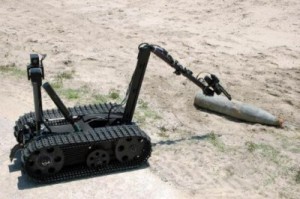In war, we often take for granted the vast array of systems designed to detect the enemy. From the phased-array on a U.S. Navy DDG to the infrared scope on a soldier, locating the enemy is the first step in gaining a firing solution or determining one’s peril. There is one place, however, where this technology has been rather absent: indoors. Detection of people indoors is often no more advanced than sound or a mirror on a stick (which can be seen). At the highest end we’ve seen thermal imaging or advanced optics systems combined with discrete robotics, conceptually mirrors on a stick on a robot. At MIT, Mr. Fadel Adib and Professor Dina Katabi have developed a potential new weapon for those in the Close Quarters Battle (CQB) environment: the Wi-Vi, an affordable and portable system by which a simple WiFi device can detect motion through walls.

While more expensive, unwieldy systems do exist, Wi-Vi is remarkable in its affordability and portability. With little more than a typical wireless router, one has the makings of a rudimentary people radar. Using an encrypted WiFi signal to differentiate the 2.4 GHz signal from white noise, multiple signals are fired into a room, reflected back, and processed. When nothing is moving, the signal is zeroed out. When objects moves, the signal changes. For each thing moving, there is a separate discernible changed return in signal, allowing the system to detect multiple objects or people. USCG and USN boarding teams would find a tactical, deployable version of this system particularly useful.
The ability to detect possible human movement in holds, around hatches, or even in CONEX boxes would be a boon to boarding teams. Tactical movement indoors are often the most dangerous; movements are limited to a small number of paths that can be easily monitored by an opponent. This especially applies to ships, where rooms and passageways are especially constrained. With a tactical version of the Wi-Vi, boarding teams could detect movement and the number of personnel in a room before entering. Wi-Vi could also potentially detect movement within a certain distance in large cargo-holds or eventually for checking CONEX boxes for potential victims of human trafficking as they move inside.
Penetration is the major challenge for shipboard use; although Wi-Vi has been tested on 8″ concrete, terrible shipboard cellphone reception has made Navy and Coast Guard personnel aware of the basic problems of signal propagation. Cellphones operate anywhere from a half GHz to 2GHz, and couldn’t receive a signal inside my patrol craft if life defended on it. The Wi-Vi system operates at 40 GHz: far less penetrating than the 2GHz of shipboard radios. Upon inquiry, Mr. Adib elaborated, “The walls with which we tested (i.e. concrete and hollow walls) have metal support; specifically, they are supported by steel frames. Naturally, most walls have metal support, and this is not a problem for the operation of Wi-Vi. However, the device does not work if the wall is fully covered with a metal sheet.”At this stage of development, then, a tactical version of the device would be best suited for wooden dhows, fiberglass fishing boats, or berthing areas with mostly false bulkheads in large commercial vessels.
It is also worth noting the identification limitations of this technology. Wi-Vi can show the number and relative movement of any objects in motion in space, but neither their specific locations, nor the presence of immobile objects. “Secure for sea” could well be the enemy of Wi-Vi onboard ships. So could complacency; teams untrained in the device might assume a “clear” reading on Wi-Vi means a room is empty as opposed to containing a very still and patient gunman.

Wi-Vi is an exciting technology for those engaged in the CQB environment – our Marine Corps bretheren may make sooner use of the tech due to the less metallic nature of most urban walls. Wi-Vi may be deployable for hunting for stowaways on a commercial vessel or trafficked humans behind a false bulkheads on dhows. With further development of lower-frequency devices, Wi-Vi might be usable for CONEX boxes and lighter metal areas of ships. The ability to deploy relatively cheap, light-weight human detection systems to the field could mean this novel MIT project is the first snowflake in the avalanche of tactical-gear to come.
Matt Hipple is a surface warfare officer in the U.S. Navy. The opinions and views expressed in this post are his alone and are presented in his personal capacity. They do not necessarily represent the views of U.S. Department of Defense or the U.S. Navy.
h/t to Scott for sending the article.


